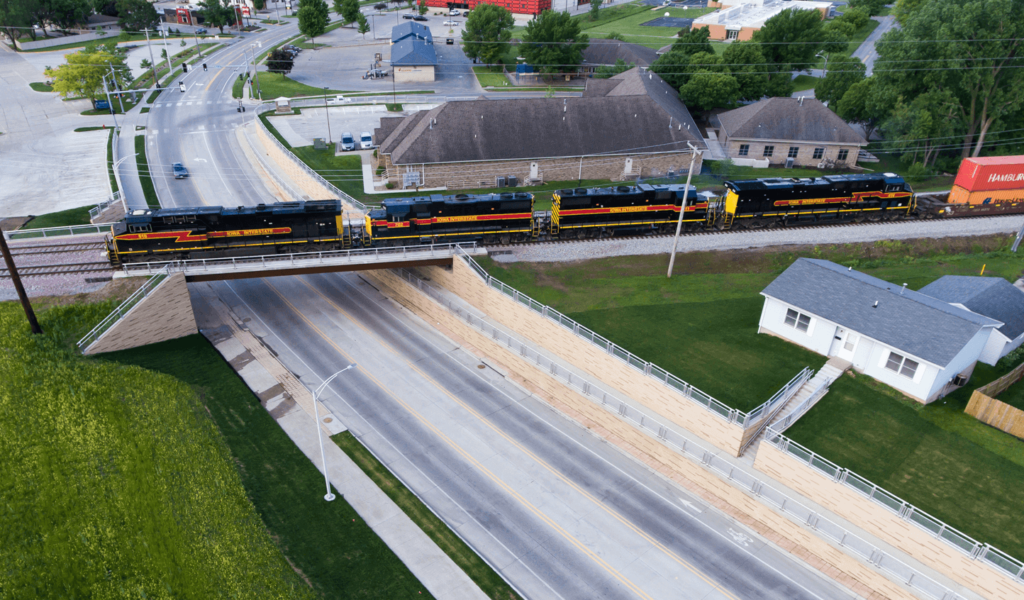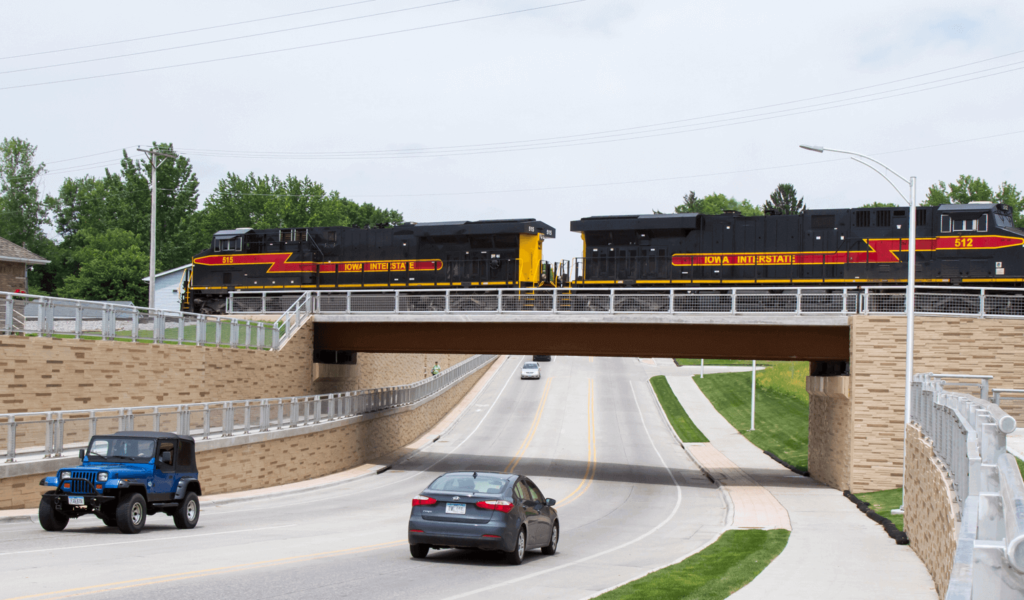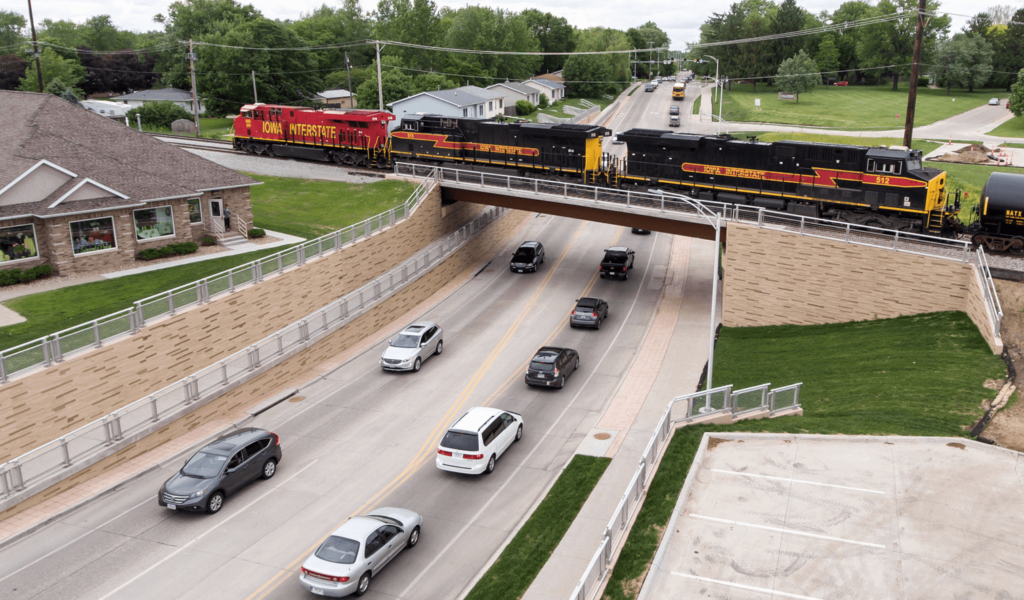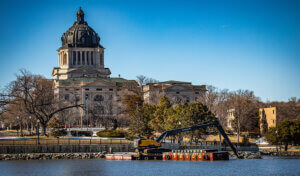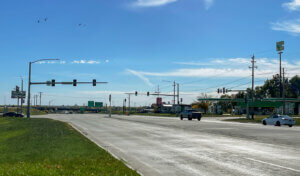
Traffic Delays Cause Extreme Hardship for Iowa City Commuters
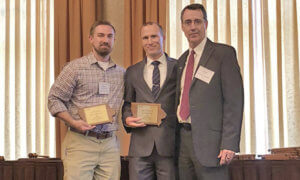
Snyder & Associates’ project manager Andy Burke, P.E., (center) accepts an ACEC-IA Honor Award for the First Avenue Grade Separation project during the 2018 Engineering Excellence Awards Program.
First Avenue in Iowa City, Iowa serves as a main north-south arterial roadway. Every day, approximately 13,000 vehicles utilize the corridor with future traffic volumes expected to increase dramatically. Due to the mixed-use development in the area, including South East Junior High School, the corridor also carries a notable amount of pedestrian and bicycle traffic.
Bisecting 1st Avenue just south of the Junior High School is a pair of railroad lines owned by the Iowa Interstate Railroad (IAIS). An average of three trains per day pass through the area and block 1st Avenue. This resulted in major traffic delays and safety concerns for vehicles and pedestrians. Traffic studies reported an average vehicle wait time of 10 to 20 minutes while the crossing was blocked by slow-moving trains. Commuters that chose to explore alternative routes were detoured four miles west to the nearest grade-separated crossing at Summit Street.
Recognizing the need for improved traffic flow and safety throughout the corridor, Iowa City officials began exploring their options in 2005. Unfortunately, seasonal flooding and other unforeseen circumstances postponed the project for many years. In 2014, Snyder & Associates was contracted to design a solution to improve the corridor with the goal of avoiding conflicts with train traffic altogether and allowing for seamless traffic flow along 1st Avenue. Instead of creating a vehicle overpass to separate the trains from vehicle traffic, the design team quickly realized that the best course of action was to lower 1st Avenue approximately 16.5′ and raise the railroad tracks 5′ to pass over the roadway.
Construction Challenges Addressed by a Creative Design
The project incorporated a unique design that required a significant change in grade and infrastructure construction. The challenges to staging and completing a project of this magnitude were substantial. Most critical to the project was keeping all transportation corridors open to the fullest extent during construction. This included an open passage for vehicle traffic, as well as train traffic.
Another major design concern was how to deal with stormwater runoff. Since the roadway would be substantially lowered, the area under the train tracks could become inundated during periods of heavy rain. Initially, a storm sewer pumping station was viewed as the best solution. However, during the design stages, the team was able to eliminate the need for the pumping station by finding a means of gravity draining the site. This resulted in significant savings in terms of construction costs and ongoing maintenance. Finally, all aspects of the project had to be carried out in a fully-developed area without having a direct impact on existing structures.
Traffic Staging, Shoofly Railroad Tracks, & Aesthetic Features

Complete Snyder & Associates/Shuck-Britson project team pictured above, front row (left to right): Subhija Rahmanovic, Structural Engineering; Diane Goering, PLA, landscape architecture and aesthetics; Andy Burke, P.E., Project Manager; Todd Knox, P.E., PTOE, traffic signal and street lighting. Back row (left to right): Jerome Hatlewick, P.E., Structural Engineering; Heather Fritz, Engineering Technician; Jordan Gustafson, Structural Engineering; Rich Voelker, P.E., Project Director
To address the vehicle traffic along the corridor, the design coordinated an onsite detour allowing one lane of traffic to traverse the corridor in each direction. This plan was simple, effective, and it kept traffic flowing while also providing a large area for construction to occur.
Maintaining unimpeded service for the IAIS, however, required a little more creativity. To that end, a shoofly railroad track was designed and utilized. Shoofly tracks were originally used by railroads in mountainous regions. These temporary tracks were primarily used to carry trains around mudslide areas. But in modern roadway construction, they’re utilized as a solution for keeping train traffic moving.
The rest of the project called for a new railroad bridge, street paving, retaining wall, storm sewer, and water main. The existing four-lane roadway was reconstructed as a three-lane section with a bike lane in each direction. The massive retaining walls required along the corridor were constructed to include aesthetic elements, such as a decorative form liner, stain, and aluminum railings.
Detailed Staging Plan Keeps Project On-Task
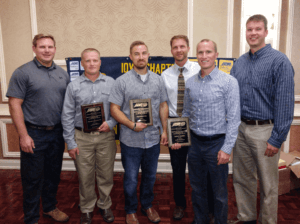
Project team members pictured above (left to right): Jordan Muller, Peterson Contractors; Zach Steffen, Peterson Contractors; Jason Reichart, City of Iowa City; Troy Culver, Snyder & Associates; Andy Burke, Snyder & Associates; Jason Havel, City of Iowa City
Construction consisted of five main stages beginning in the spring of 2015 and concluded in the fall of the following year. The initial stages included the installation of the new water main, storm sewer, and construction of the shoofly tracks. The middle stages included building the retaining walls, bridge abutments, and wing walls, performing grading and paving work, and installing the new IAIS Railroad Bridge.
Latter stages saw the completion of mainline paving and junior high paving, along with a critical closure to connect the new IAIS railroad across the onsite detour roadway. The final retaining wall and side path construction wrapped things up, along with an adjacent parking lot.
The total project construction cost was approximately $10 million. Project funds included $2.4 million from the Surface Transportation Program (STP), $500,000 from the Traffic Safety Improvement Program (TSIP), and $550,000 from the IAIS. The remaining dollars were covered by general obligation bonds.
During the Iowa Chapter of the American Public Works Association’s (APWA) Annual Fall Conference Awards Banquet in 2017, Snyder & Associates proudly joined staff members from Peterson Contractors, Inc. and the City of Iowa City to accept the Project of the Year Award in the Transportation category, greater than $2.5 million. The project also received the American Council of Engineering Companies (ACEC) of Iowa Honor Award in the Transportation Category during the 2018 Engineering Excellence Awards Program on May 9, 2018.
